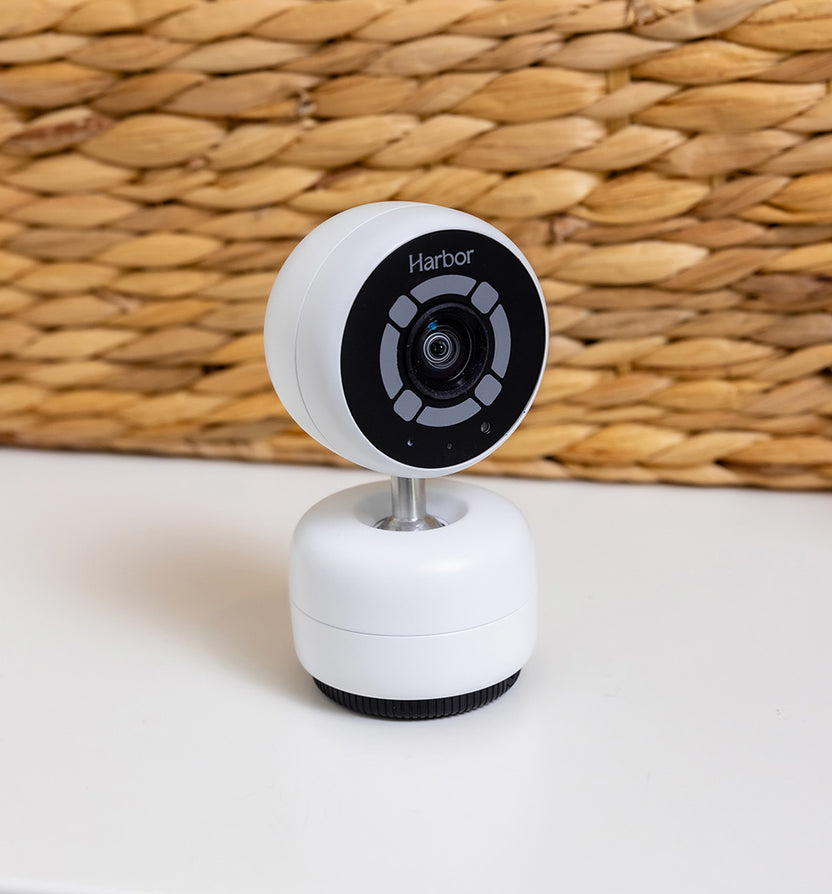
Expert Baby Sleep Tips for
the First 12 Weeks
How to help set your newborn up for healthy sleep habits
Harbor’s mission is happier parents and healthier families, one restful night at a time.
The world of infant sleep can be challenging, especially for new parents; however, understanding the science and fundamentals of sleep can empower you to establish healthy routines that set both you and your baby up for success.
Studies show that better sleep is the foundation for health and happiness [3]. Cultivating healthy sleep habits equip your baby with the skills and routine necessary to self-soothe and fall back asleep independently—without sleep crutches—when waking in the middle of the night. Harbor is here to help guide you through the world of infant sleep and provide the expertise you need. Together, we can create a nurturing plan of action where both you and your baby can thrive.
Get our Sleep Guide as a starting point.
Babies under 12 weeks need 15-16 hours of sleep to be well-rested, function properly during the day, and continue physical and mental development. In the initial stages, newborns will often drift into brief naps, lasting just one or two hours as their tiny bodies learn to establish rhythmic order. Around the two-month mark, a transformation begins with the help of newly released hormones, melatonin and cortisol. During this time a baby’s sleep heads towards consolidation; they begin to operate on the normal rhythm of day and night sleeping patterns [1]. Ensuring your baby gets the sleep they need requires careful planning and close attention to detail but is ultimately achievable for all parents, despite how overwhelming it can feel.
Maintaining consistent sleep routines during naps, bedtime, and night wakings are important for promoting healthy sleep habits. By choosing a regular bedtime and sticking to it, along with a bedtime and night waking routine, you create a sense of security and predictability that helps babies learn to self-soothe. Consistency in sleep routines not only fosters a feeling of security but also contributes to better rest and overall well-being for your little one. Establishing healthy sleep habits means more quality sleep and more quality awake time as a family.
Understanding the Phases of a Baby’s Sleep
Babies experience different phases of sleep during the night, including moments of deep sleep and restlessness. These phases are specific to babies under three months and consist of periods of “active sleep” and “quiet sleep”. Understanding these cycles is essential for helping your baby establish healthy sleep habits and ensuring everyone gets a good night's rest.
Quiet Sleep
During quiet sleep, your baby's body and mind are at their most relaxed state. This phase is crucial for their growth and development.
Active Sleep
For babies, active sleep is an immature form of Rapid Eye Movement (REM) sleep. During this phase, your baby's sleep is more restless, and they are more easily awakened. It's during active sleep that most dreams occur, and your baby might stir, make sounds, or even briefly wake up [4]. These sleep cycles typically last 50-60 minutes, and as babies shift between active and quiet sleep phases throughout the night, it's essential to help them learn to fall back asleep on their own during these transitions [2].
Charting a Course for Safe Sleep
A safe and comfortable sleep environment is crucial for your baby's sleep journey. Here are some key tips for creating the ideal sleep environment:
- Always follow safe sleep guidelines: do not use bumper pads, blankets, loose bedding, or stuffed animals in the crib. Use only a mattress and a tight fitting crib sheet in the crib. Make sure there is nothing in reach of the crib. The American Academy of Pediatrics maintains a list of safe sleep guidelines.
- Avoid distractions like mobiles or anything in the infant’s field of view above the crib.
- Embrace sound: Use white noise throughout the night and for naps. White noise can help drown out sudden noises and provide a soothing background sound.
- Make the room dark: Make the room very dark at bedtime and pleasantly dark for naptime. This helps signal to your baby that it's time to sleep. Blackout curtains or even dark paper temporary blinds over the windows can make a significant impact on your child’s ability to sleep.
- Maintain a comfortable climate: Keep the temperature in the nursery between 68-72 degrees Fahrenheit (20-22 degrees Celsius). This ensures a cozy and consistent sleep environment.
- Add a little circulation: Consider adding a fan to keep the air circulating. This gentle breeze can help regulate the temperature and avoid stagnant air to create a comfortable atmosphere for your baby's slumber.
Navigating Nighttime Wakings
It's natural for babies to wake up during the night, but you can help them gradually learn to sleep for longer stretches. Here's how to handle nighttime wakings:
Let baby cry briefly
Allow your baby to cry for a short interval based on Harbor’s Sleep Training Interval Guide to encourage them to self-soothe and fall back asleep. Allowing your baby a brief moment to fuss or cry during these short transitions is beneficial though can be difficult for parents. It gives them the opportunity to practice self-soothing techniques and work on skills to eventually fall back asleep on their own. When babies learn to self-soothe and fall back asleep independently, they are less likely to fully wake up, cry, or require your intervention to go back to sleep. Look in on them through a monitor to ensure there are no issues, but you should allow them to fuss for a few minutes before intervening. Science has proven brief periods of crying are not harmful for your child or mother/child bond.
Soothing techniques
After the short self-soothing trial, you may include soothing techniques like loud shhh sounds, gentle tummy rubs, or offering a pacifier from the side of the crib. Avoid picking up baby to allow them to self soothe. If your baby is still awake after three soothing attempts, they may be genuinely hungry and ready for a nighttime feed.
Nighttime feeding routine
When it's time for a nighttime feed, turn on a dim light, turn off the white noise, and unswaddle your baby. The feeding should last no longer than 30 minutes, including burping and a diaper change halfway through.
-Back to sleep: Finish feeding before swaddling your baby and offer a few more minutes of nursing or the final bit of the bottle while swaddled if needed. Once back in the crib, turn off the lights and turn the white noise back on. If baby has difficulty settling, utilize Harbor’s Sleep Training Interval Guide and soothe baby from the side of the crib.
Navigating the Nap Challenge
Naps can be unpredictable until around 4-5 months old. When it comes to your baby's daytime naps, consider following these gentle guidelines for smoother sailing:
Crib Naps
Strive to offer at least two out of three naps in the crib, accompanied by swaddling and comforting white noise. Establishing a nap routine that includes the crib is greatly beneficial as babies thrive on predictability and consistency.
Mind the Duration
Keep in mind that naps should be no longer than 2 hours.
Morning Ease
Just as the morning sun rises gently, morning naps are usually easier to establish in the crib. It's often the best time to gently encourage your baby to find comfort in their perfect sleep space.
Rest. Easy.
As you navigate the sleep journey for your baby, remember Harbor is here to provide you with unwavering support and a sense of security. We understand that parenting can be challenging, and that's why we offer a warm and welcoming community where you can find the answers, guidance, and comfort you need through expert care. We believe in the power of safe and good sleep. And we’re here to help you get all of it.
